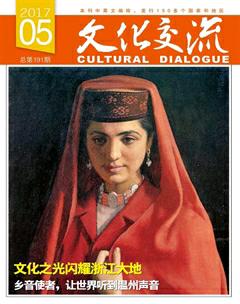向世界讲述中国艺术的故事
俞吉吉?童健?廖垣
2017年2月,一个外国人的名字在各大网站引起关注。他是高居翰,是西方中国艺术史学界最具有影响力的权威学者之一,生前长期在美国加州大学伯克利分校执教,并担任过著名的美国华盛顿特区弗利尔美术馆中国书画部顾问,该馆以收藏东亚文物著称。2014年2月14日,高居翰仙逝于伯克利家中。
这个被称为“最懂中国画的美国人”曾有一个心愿,建立一座中国艺术资料库,让全世界的中国艺术史学者,都可以在此获取丰富的研究资料。
今年,恰逢其逝世三周年之际,这个愿望得以实现:2月18日,高居翰数字图书馆正式在中国美术学院南山校区的贡布里希-高居翰纪念图书馆内发布上线。通过中国美术学院图书馆官网入口或者直接登录http://210.33.124.155:8088/JamesCahill/就可以访问高居翰数字图书馆,在大师书房里看到这位享誉世界的学者穷尽一生得到的宝贵资源,也是其送给美院和全世界爱中国艺术的人的礼物。
研究中国艺术的西方权威学者
高居翰,艺术史家、策展人和收藏家,美国加州大学伯克利分校艺术史系荣誉退休教授,中国艺术史学者和学術权威。
高居翰1926年8月13日出生于加利福尼亚州布拉格堡。他就读于伯克利高中时,对文学和音乐产生兴趣;1943年,进入加州大学伯克利分校,起初为英语专业,后转入日语专业。1946-1948年,参军并担任日语及韩语翻译。在亚洲期间,他开始收藏绘画作品。1948年,他返回伯克利继续学业,1950年获东方语言专业文学学士学位。后追随知名学者罗樾修习中国艺术史,分别于1952年和1958年在密歇根大学安纳堡分校获得硕士和博士学位。1954年至1955年,他在京都大学跟随岛田修二郎研习东亚艺术史。1956年,在斯德哥尔摩担任瑞典艺术史学者喜龙仁的助理。同年,高居翰返回美国。1958年至1965年,担任华盛顿特区弗利尔美术馆中国艺术策展人,1965年起,担任加州大学伯克利分校艺术史系中国艺术史教授,直至1995年荣誉退休。
1995年,“美国大学艺术学会”授予高居翰“杰出艺术史教学终身成就奖”。2007年,“美国大学艺术学会”授予他“艺术写作终身成就奖”。2010年,他获得由“史密森学会”颁发的“弗利尔勋章”,以表彰他在中国艺术研究领域的终身成就和杰出贡献。
高居翰著作等身,其中包括被广泛阅读且多次再版的《中国绘画》,这本书成为中国艺术史课程的必读经典教材。他的五卷本中国晚期绘画研究系列出版了三卷——《隔江山色:元代绘画》、《江岸送别:明代初期与中期绘画》、《山外山:晚明绘画》。他还出版了《中国古画索引》。他的著作被翻译为中文、日文、韩文以及多种欧洲国家文字。他的书籍和文章在中国大陆和台湾皆收获了广泛的读者。
线上大师书房珍贵资源得之不易
进入高居翰数字图书馆,可以看到馆藏资源分为大师生平、高氏藏书、著述研究、视频讲座、图像典藏、博客典藏、江岸送别等系列版块。其中包括了2200余册图书、3600余张他亲自挑选的教学幻灯片、12000余幅在全球各大博物馆拍摄的中国美术史数字图像和其他珍贵历史资料图像。轻点鼠标,美轮美奂的中国古代艺术世界就可以呈现在眼前。还有可供免费下载的论文资源、高居翰所撰写的演讲文稿和展览序言等,内容甚是丰富。
有一个细节——这里分享的大量中国艺术品照片里,依然保留着高居翰用数码相机拍摄时的编号和顺序。浏览时,你看到的也是他在台北故宫博物院等全球各大机构实地拍摄所走过的路。
这些珍贵的资源,高居翰其实得来不易,也是他对夙愿的执着坚守。
高居翰主讲、录制的60余集中国美术史讲座视频《溪山清远》系列和《凝视过往》系列也在这个数字图书馆中。在高居翰晚年,研究欧洲绘画的书籍充斥世界的图书馆,但是中国绘画的研究资源还十分稀缺。他在视频讲座的笔记中表达了自己的忧虑:“只要设想一下,如果你想写一本书,但没有相关的资源以及专业训练可资利用,你就会理解我的负罪感了,也会理解我发起这个项目的原因了。”
拖着病体录制视频讲座是高居翰晚年的主要工作。那段日子里,高居翰每天花两三个小时在电脑面前,制作他关于中国美术和美术史的系列讲座视频,一直持续到去世前。高居翰认为,为了避免知识的断层,他应该为年轻一代留下那些他认为他理解和知道的一切。
2013年3月,为了接受和整理高居翰教授捐赠给中国美术学院图书馆的私人藏书,现在的中国美术学院图书馆馆长张坚带着两位助手,在高先生家住了20多天。
“白天,我们在楼上编目和整理图书。有录制的时候,高居翰先生就会沿着楼梯轻轻上来说,这段时间你们尽量不要走动,以免杂音录到视频里。我们就保持不动,一声不吭。”张坚回忆道。
高居翰也曾经和张坚玩笑着说,自己是新儒学的信徒,儒学的信条促使他去做这些事。因为,在中国的儒学中,前辈将知识传递给下一代,是一种传统。
“我不想我的图书馆变成我的纪念碑”
“让中国的视觉艺术成为世界的学问。”张坚回忆起项目的缘起和经过。
高居翰自上个世纪九十年代起就与中国美术学院保持着密切的联系,先后多次到该校讲学,也是1997年中国美术学院设立“潘天寿纪念讲座”后的第一位受邀主讲人。
高居翰向中国美术学院捐赠图书和资料这件事,从2012年12月就开始沟通策划。其中的一个故事让张坚记忆深刻。
2013年1月23日深夜,美院的几位教授收到了高居翰发来的邮件,言词有些激动,他说:“我不想我的图书馆变成我的纪念碑,我不想这个图书馆只被研究高居翰的人使用,而应是研究中国艺术、日本艺术和世界艺术的人使用。它是一个研究性的图书馆,不是高居翰的纪念碑。”后面跟了6个感叹号。
原来,是高居翰的中国友人,给他发了两张美院贡布里希纪念图书室的照片。
1994年,世界著名艺术史家贡布里希将藏书捐献给中国美院,学校特辟“贡布里希纪念图书室”,用以珍藏这批宝贵的文献、实物。然而,限于当时的条件,图书室有段时间尚未对外开放。因此,在照片中,图书室虽然窗明几净,却没有读者。
这便是高居翰来信的缘由。他期待中的图书室不仅要充分开放,而且要允许研究者借阅。
出人意料的是,24日凌晨5时,高居翰的邮件又来了。他说:“我已经无法入睡了,睁着眼睛在床上躺了一个小时,这个时候一个伟大的想法逐渐出现在我脑海里,我打开床头灯,在桌边的卡片上记下来,现在我要到电脑上把它们记下来,我可以明天再睡的。”
说的,正是像现在这样建立中国艺术图像库的构想。
2013年6月24日,高居翰先生捐赠的112箱共计2000余册个人藏书,顺利从美国加州运达中国美术学院图书馆。这些藏书,主要是欧美国家自20世纪以来中国美术史研究的代表著作、欧美国家的中国艺术收藏家的著录和相关资料,以及西方学者翻译和研究中国文化的各类著作。和藏书一起来的,还有13000多幅中国美术史数字图像资料、教学幻灯片。它们中的大部分是高居翰先生奔走于世界各大美术馆时拍摄的珍贵资料。
為了让这批捐赠图书更好地在学院教学、研究和创作中发挥应有作用,2013年7月学院图书馆决定,建立新的贡布里希-高居翰图书馆,并把这个新的图书馆从南山校区图书馆六楼搬迁到三楼。2015年9月,新的贡布里希-高居翰图书馆正式对外开放。
2014年夏天,美院开启了“高居翰数字图书馆”项目,一批20余人学生志愿者参与到了对这批图像资料的标引工作中。
“作为中国美术学院图书馆的一个特色资源,高居翰数字图书馆要真正达到高先生的设想,让这个数字图书馆成为具有世界性的学术影响力的中国视觉艺术研究中心,当然还有很长、很长的路要走”,张坚表示,未来,图书馆的资源还会不断充实。
Art-Focused Donations by James Cahill Housed in China Academy of Art
By Yu Jiji, Tong Jian, Liao Yuan
Before he passed away on February 14, 2014, James Cahill, considered one of the worlds top authorities on Chinese art, decided to donate his private library to China Academy of Art based in Hangzhou, the capital city of Zhejiang in the east of China.
James Cahill first visited the academy in Hangzhou in the 1990s. He was the first one who gave lectures at Pan Tianshou Memorial Lectures set up in 1997 by China Academy of Art. The preparations for his donation started in December 2012. At the midnight of January 23, 2013, several professors with the academy received an email from Cahill saying that he didnt intend his library to be his monument or to be used by those who specialized in the studies of James Cahill. Instead, he wanted it to be a library open to all those who study Chinese art, Japanese art and world art. It should be a library for research.
It turned out that early that evening Cahill had been upset by two photos of the Gombrich Library housed at China Academy of Art, sent by a Chinese friend. Gombrich donated his books and artifacts to the academy in 1994. But for a while, the library didnt open to the general public for some reasons. The photos showed the Gombrich Library was empty without a reader. At about five oclock in the morning, Cahill sent another email saying that he couldnt sleep and he had just hit upon an idea. It turned out that he wanted to build a library of Chinese paintings.
In March 2013, Zhang Jian, now director of the library of China Academy of Art, traveled all the way with two assistants from Hangzhou to USA. They stayed at Cahills home for more than 20 days, sorting out books that were going to the library at the academy.
During the day time they catalogued books upstairs and Cahill would come up to ask them to be quiet if he was to make video records of his lectures on Chinese art. James Cahill joked with Zhang Jian that he was a disciple of neo-Confucianism and that it was the creed of the Confucianism that drove him to pass his knowledge to future generations. Confucianism gives top priority to the tradition of passing knowledge on to the future.
On June 24, 2013, his donations, packed in 112 cartons and shipped from California, USA, arrived at the library at the academy. The donations include 2,200 representative books on Chinese art written by westerners in the 20th century, the catalogues, books and related documents about collectors of Chinese art in the west, and translations and researches about Chinese culture done by western scholars. The donations also include over 12,000 digitalized Chinese paintings and 3,600 slides which he had made and used in teaching. Most photos in the digitalized collection resulted from his trips to art galleries and museums across the world. The photos still carry the original serial numbers automatically produced by the digital camera Cahill used. Also among the donations are video footages of over 60 lectures on the Chinese art and the history of Chinese art. During the last years of his life, Cahill made all these video lectures at home, spending two or three hours a day.
In July 2013, the academy decided to consolidate the resources and strengths and set up the Gombrich-Cahill Library and moved this special library from the sixth floor to the third floor of the library building. In September 2015, the library officially opened to the general public.
In the summer of 2014, the academy launched a project to digitalize James Cahill Library and put it online eventually. A group of over 20 student volunteers gathered to do the work. On February 18, 2017, the library went online (). It can be accessed directly or through the website of the library of China Academy of Art. Though visitors can only view titles of the books in Cahills collection, they can watch lecture videos, view paintings and other precious images. They can also download papers and speeches free of charge.

